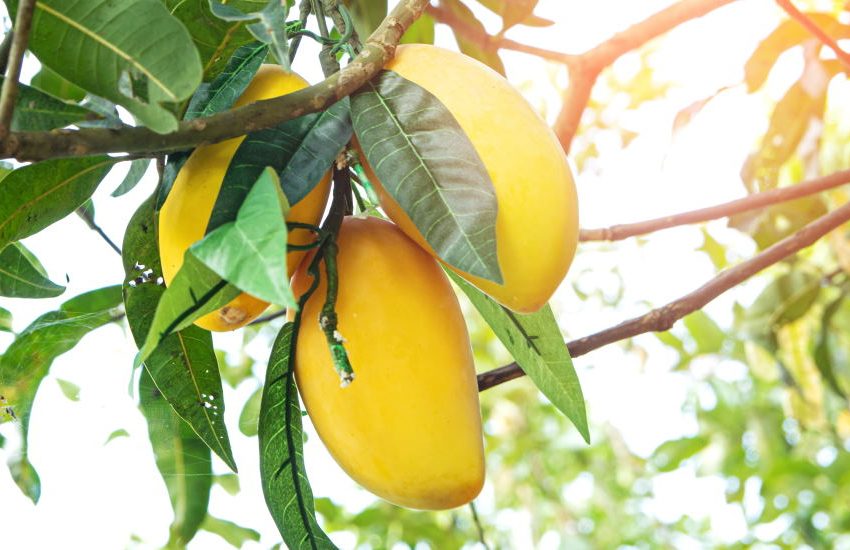Why is My Sago Palm Turning Yellow? And How Can I Solve This?
In this article, we are going to examine the reasons for a Sago Palm turning yellow and the solutions we can apply.
Sago palms are great indoor plants, and when healthy, they have dark-green leaves. Fronds turning yellow means something is wrong with your sago palm. So what may be the cause for a sago palm to turn yellow?
There can be many reasons, including but not limited to; overwatering, underwatering, root rot, too much fertilizer, transplant shock, or mineral deficiencies.
How to Identify Nutrient Imbalances with Sago Palms
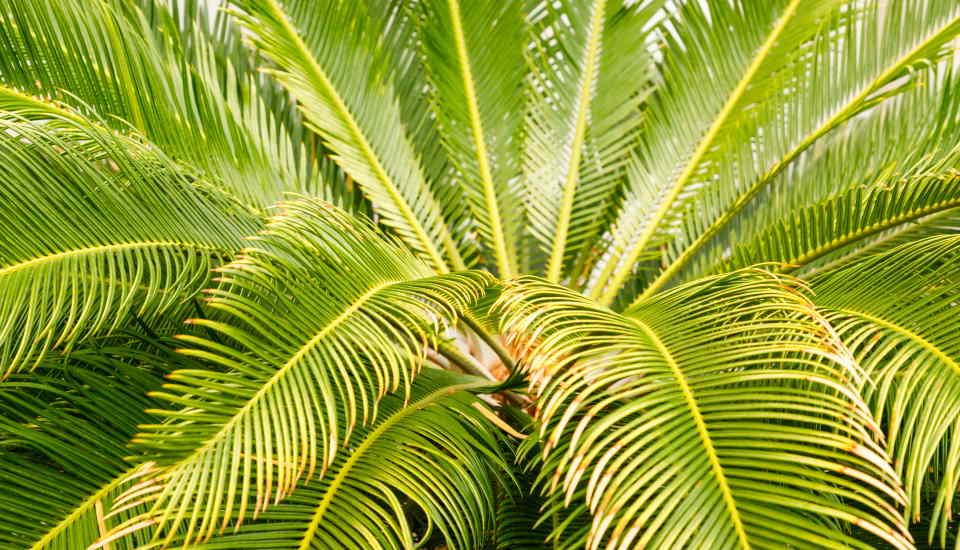
Manganese
When there is not enough manganese in the soil, the plants begin to turn yellow, starting from the newest leaves. Yellowing starts as spots and streaks; then, all the foliage turns yellow. The yellow fronds eventually turn brown, and this means they are almost dead.
If the soil is too acidic, higher than 5.5 pH, the roots will not be able to absorb nutrients properly.
A good dose of manganese sulfate should be applied to the soil. The dose depends on the size of your plant and soil acidity. For a small plant that doesn’t have drainage problems, an ounce of manganese sulfate watered in with half an inch of water should do the work.
Do not confuse manganese and magnesium; they are two different things.
Magnesium
Magnesium deficiency is not as serious as manganese deficiency. Magnesium deficiency will not kill the sago plant, but it will harm it cosmetically. It won’t be possible to heal the yellow leaves. You need to cut them away and let healthy leaves replace them.
The giveaway sign of magnesium deficiency is marginal chlorosis on mature fronds on a sago palm. The center of the fronds will keep their greenery. Only the edges of the leaves will turn yellow.
Nitrogen
Nitrogen deficiencies are usually found in outdoor sago palms. Indoor-grown sago palms don’t need that much nitrogen. They need it in slow-releasing forms, though.
Nitrogen deficiency will not turn your plant yellow. Instead, it will turn them into pale light green, and they will lose their vibrant green color. It will seem like a yellowing that never actually turns into yellow.
Plants need nitrogen for the growth of leaves, stems, and branches, as well as to keep a healthy level of chlorophyll.
Simply put, the cure for nitrogen deficiency is to improve the soil with a nitrogen-rich fertilizer. Buying a proper fertilizer is an easy and convenient choice if you are growing your sago plant indoors. For your outdoor garden, you can try other options like compost or manure.
Nitrogen is very important, but your plant can suffer if there are excess amounts of nitrogen in its soil too. If the soil is too high in nitrogen, the plant will put all its energy on growing new leaves and halt flowering. It will seem healthy otherwise but will not flower.
Iron
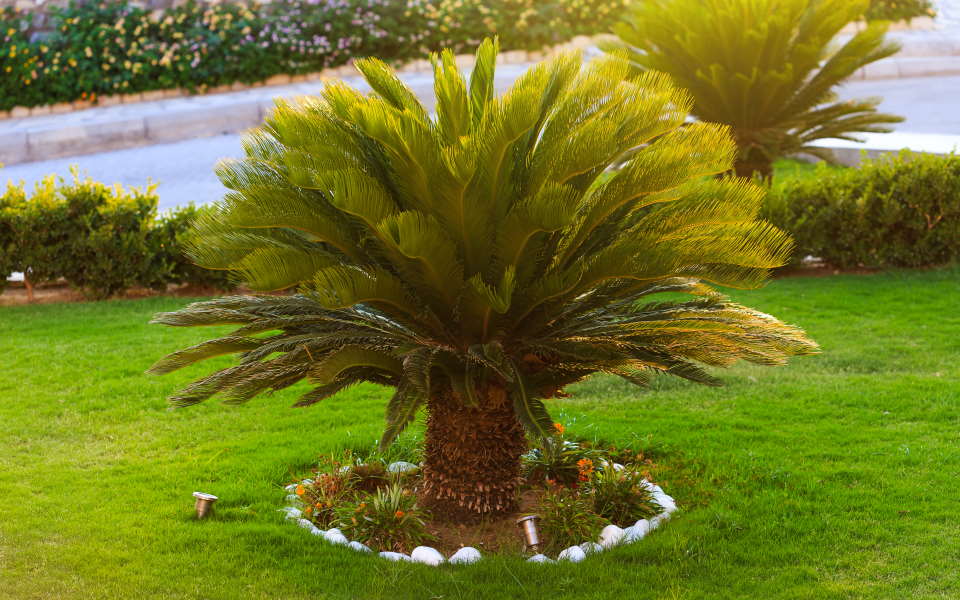
Occasionally you should feed your sago palms with iron chelates to prevent iron deficiency. Cycad fertilizers have this most of the time. Iron deficiency will result in chlorosis.
Iron deficiency will give itself away by interveinal chlorosis on mature leaves – the leaves will stay green, but the leaf tissue surrounding the veins will turn yellow.
Pro Tip: Wood ash is an abundant source of calcium, potassium, magnesium, and phosphorus. So if you are using a garden incinerator to burn pruned branches, you can work some wood ash into your compost and then work a small amount of the compost into your garden soil to decrease its acidity.
Acidic Soil Prevents Nutrient Absorption
Before you run off and buy off a lifelong supply of these nutrients, you should check your soil pH first. When the soil is too acidic, the roots will not be able to absorb the nutrients from it.
The ideal soil pH for sago palms is between 5.5 and 6.5. If the soil pH is below this interval, it won’t matter how many nutrients you put in it, and the roots will not be able to use them.
You need to check the acidity of your soil levels. Most garden stores and chain retailers, including Amazon.com, have really affordable DIY soil test kits or digital meters that will help you with the necessary readings.
Overfertilization
Leaf discoloration is usually caused by mineral deficiencies, but overfertilization can also cause similar symptoms. Too much fertilizer or applying fertilizer to wet foliage may cause fertilizer burn, which gives itself away by scorching or burning the plant’s foliage.
The symptoms include but are not limited to root damage and discoloration/yellowing of the leaves. It can start to show itself as soon as 24 hours after applying the fertilizer. You should feed your sago palm with an organic water-soluble fertilizer 3-4 times a year. The same goes if you are growing your sago palm indoors or outdoors.
Sunburn
Too much direct sunlight can lead to sunburn. Sago palms like bright but indirect light. This often occurs when you move your sago palm from indoors to outdoor during the summer period.
Sunburn symptoms to look for are dark burn spots and yellowing of the leaves which are under direct sunlight. You can also see the tips of the leaves darkening under direct sunlight.
Underwatering
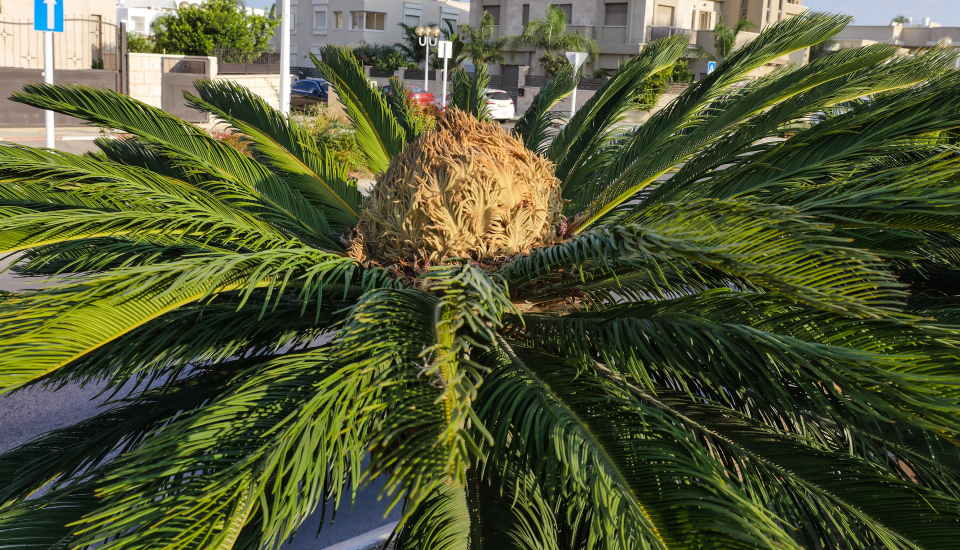
Water provides the hydrogen necessary for photosynthesis to form glucose. If your sago palm is not getting enough water, it will start to drop some of its leaves to conserve the water it has.
Before your sago palm starts dropping leaves, the leaves will start to yellow as they are not benefiting from photosynthesis and getting enough glucose. Other symptoms of underwatering include dry, sand-like soil and dropping of the old leaves.
Overwatering
Overwatering can also cause leaves to turn yellow in sago palms. If your soil doesn’t have enough drainage, applying too much water will cause waterlogging and prevent roots from breathing and absorbing nutrients from the soil, which will then cause the roots to start rotting.
Cold Damage
If your sago palms’ leaves are turning yellow during the winter, it can be because of cold damage. Intense colds will cause your sago palms’ leaves to be yellow or transparent spots occur between veins.
Intense cold causes sago palms to break down chlorophyll into smaller molecules, and eventually, they will disappear. As the green pigments disappear due to the lack of chlorophyll, other pigments within the leaves start to show their colors.
Transplant Shock
When young sago palms are transplanted, they can feel stress due to many causes, and this is called transplant shock. The plant may have a hard time rooting in the new environment, which may cause yellowing of the leaves.
When your plant fails to root properly, it won’t be able to get water and nutrients from the soil.
Yellowing can also occur on newly potted sago palms due to poor watering and too much or too little light.
Low Humidity
If your sago palm is exposed to low humidity for too long, it may cause its fronds and leaves to turn yellow. Low humidity means there is not enough water for photosynthesis. Your plant will not survive without photosynthesis, so it will start to use up the stored water in its leaves and fronds. This will eventually cause them to yellow and wilt.
Pests and Diseases
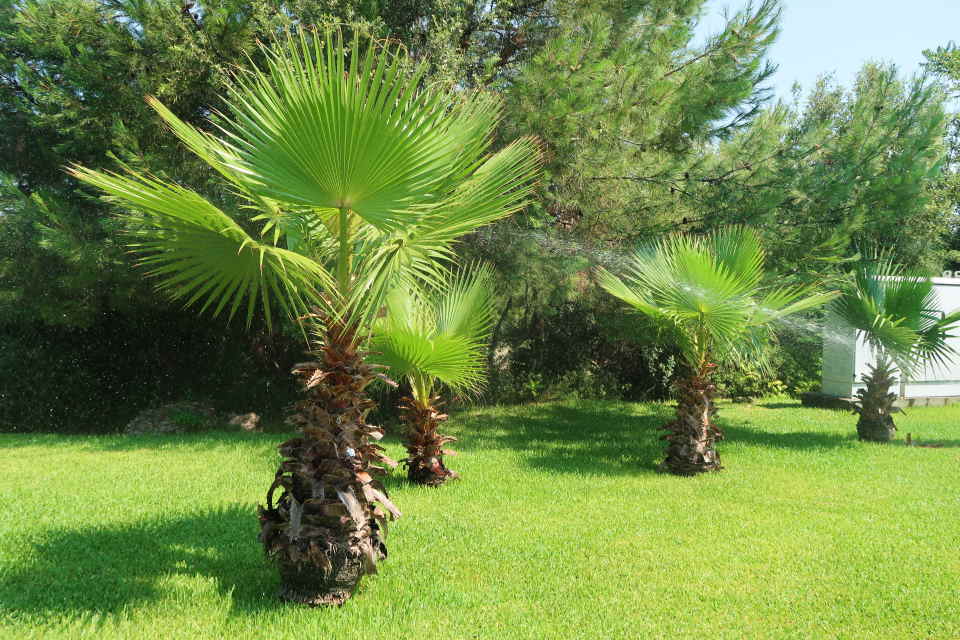
Pests and insects can be another reason why you are seeing yellow leaves on sago palms. Pests such as aphids, spider mites, and scale insects turn fronds and leaves yellow when they bite the plant. You can check your plant for sticky substances and visible webs left by mites.
Scale Insects
Scale insects are the biggest pest threat to sago palms. Sago palms don’t usually attract too many insects, but scale insects find the sap in the leaves tasty, and they can do extensive damage pretty quickly.
Scale insects are dangerous. They suck the sap from the fronds and leaves, causing yellowing, browning, and eventually bringing growth to a halt. Since sago palms only grow two inches a year at most, it is not good to have anything threatening that.
The most common scale insect to bother sago palms are mealybugs and the Asian Cycad Scale (Aulacaspis Yasumatsui).
Mealybugs only eat the sap from the leaves, while the Asian Cycad Scale infests every part of the plant. Though they are similar in looks, the Asian Cycad Scale is harder to evict since it infests every part. No part of the sago part is immune.
When your plant is infected by these, they cause yellow spots on the leaves, which sort of look like you have sprayed bleach on your plant from a distance.
Contact miticides like neem oil are effective against both of these scale insects. You can use other kinds of insecticidal soaps for coating the leaves too.
These insects feed on the sap, lay eggs, and then poop honeydew. Then ants come to feed off the honeydew. You need to repeat treatments until all are taken care of.
Rinsing the leaves under tap water can knock off the insects, and washing the leaves with insecticidal soaps will get rid of the honeydew, deterring ants.
Temperature Fluctuations May Cause Sago Palms to Turn Yellow
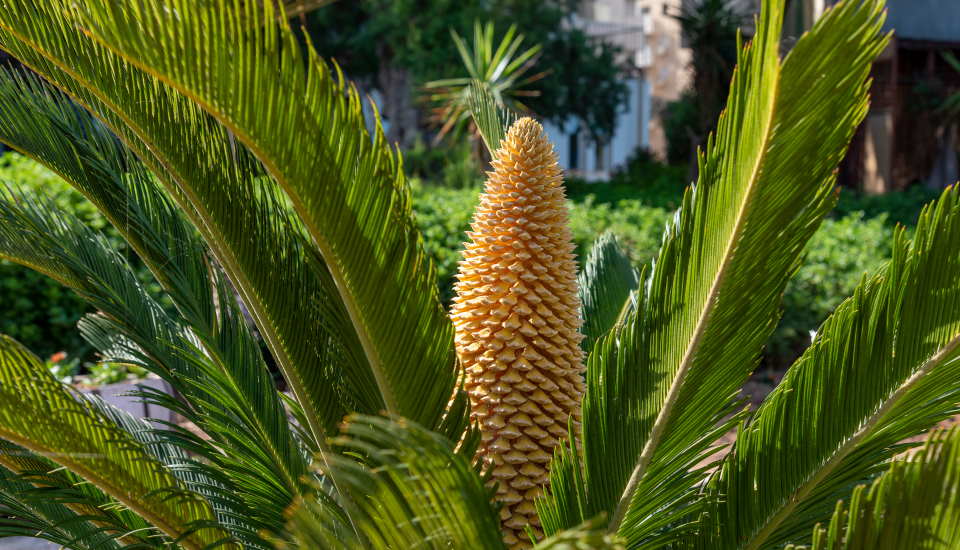
In the summer, the fronds can get sunburned, as we mentioned before. When the yellowing is caused by too much direct sunlight, you can see patches of yellow and some browning on the leaves.
You can fix this by giving the plant a partial shade. Put it under a taller plant or at a place where it doesn’t get direct sunlight.
Yellowing can also be caused by the cold weather, especially if you are growing your sago palm outdoors. Sago palms can endure cold at around 15F; lower than that will cause the sago palm to suffer.
If the weather is cold, you can try to insulate the plant with something. A burlap sack, a bed sheet, or a bath towel will do the trick. It needs to be protected from the cold.
When it’s below freezing temperature, frostbite will cause yellowing in just one or two nights. If the cold is sustained for longer periods of time, the leaves will turn brown and die.
When the cold is gone, the yellow and brown leaves should be pruned.
How to Fix A Yellow Sago Palm
If the leaf coloration is not extensive and prolonged, it can be fixed if the necessary measures are taken.
Most of the time, applying a slow-release fertilizer with potassium, magnesium, and nitrogen should stop the sago palm from yellowing. There are some other things you can do to fix yellow leaves, depending on the cause.
Apply a Magnesium Supplement
Perform a soil test and determine the insufficient nutrients; usually, it will turn out to be magnesium. After that, you can dissolve a magnesium-rich supplement in water, such as Epsom salt, and apply it to the soil to fix the deficiency.
Other common slow-release fertilizers we might suggest using for your palm trees are Miracle-Gro Shake’n Feed and Alpha Chemicals Potassium.
Move Your Sago Palm to A Warm Place During Winter
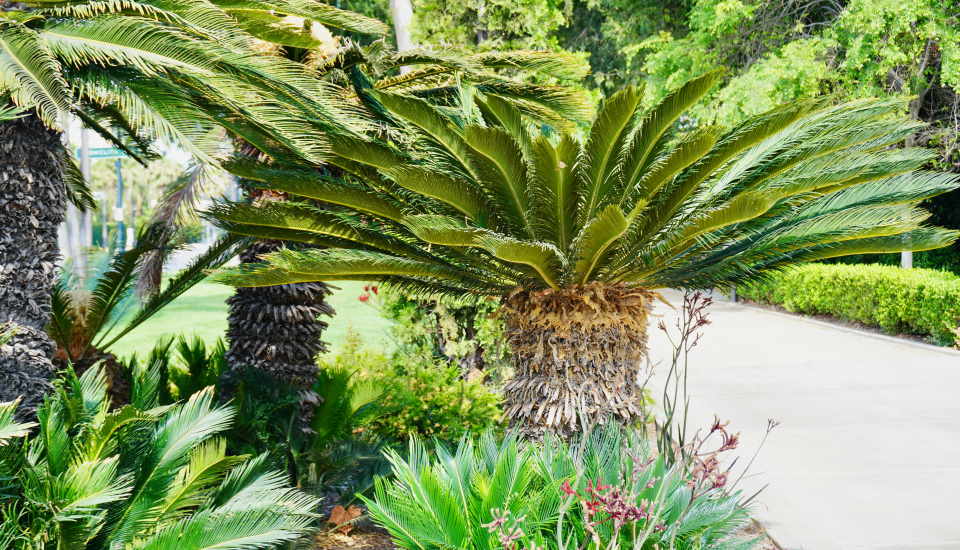
To solve a cold draft problem, you might want to move your sago palm to a warmer location away from drafty doors and windows. If your sago palm is planted outdoors, you can use frost cloths to protect your plants.
The frost clothes we would suggest are REMIAWY Plant Covers Freeze and Alinnart Plant Covers Freeze Protection.
Move Your Plant Away from Direct Sunlight
If the yellowing is caused by sunburn, you should move your sago plant to a new location away from direct sunlight. Bright places without direct sunlight are the best light conditions for sago plants. If you don’t want to move your plant, you may consider putting on a light curtain to block direct sunlight that is causing the yellowing on sago palms fronds and leaves.
Water Sago Palms Once a Week at Most
Both overwatering and underwatering are unhealthy for sago palms. The best way to water a sago palm is to feel the soil with your finger and water only if it is completely dry.
If you keep watering while it is still wet, you risk overwatering. Also, if you wait until the soil is desert-like sand, then you might be underwatering.
So, feel the soil with your finger, and when it is completely dry soil, water it. It should at least be one week and can easily be 2-3 weeks, depending on the season.
If the soil is hardened or waterlogged due to overwatering, repot the plant into a properly draining potting mix.
Treat Pests and Diseases
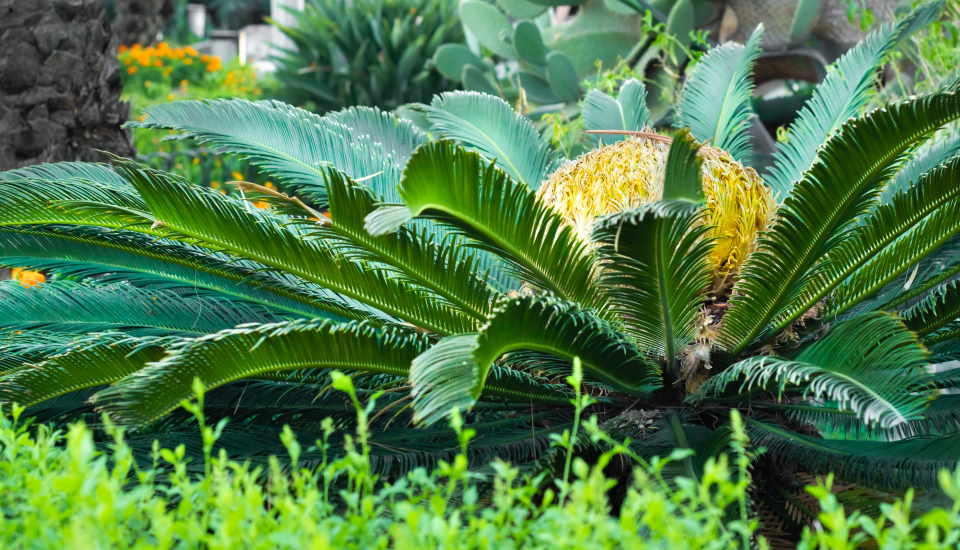
If the reason your sago plant is suffering is pests such as spider mites, scale insects, and thrips, get rid of them by wiping your sago plant’s fronds and leaves under tap water and then spraying the plant with a neem oil solution.
You should spray all the parts of the plant with this organic pesticide, including under the leaves and fronds. Tiny pests like to hide under the leaves.
Apply Fertilizer 2-3 Times a Year
A proper fertilization schedule needs to be put into work to prevent overfertilization. Ideally, you should fertilize your sago palm three times per year.
Increase Humidity for Your Sago Palms
You can raise the humidity in a room by placing water trays around or using a room plant humidifier. Move your sago palm to high-humidity areas and let them sit there for 5-10 hours a day.
If you don’t want to move your sago palms, then you should use a humidifier to increase the humidity around the plant. You can also consider misting, but it can cause fungal issues, especially in already weakened sago palms.
Should I Remove the Yellow Leaves?
Yellow leaves don’t look nice, and you may find yourself asking if you should remove the yellow leaves. Whether or not to cut off the yellow leaves will depend on what you want to achieve. Yellow leaves can be cut off for aesthetic reasons or to promote growth.
But keep in mind that yellow leaves can recover if it is not too late and they are already brown and dead. With proper care, they can photosynthesize and get their green color back in not so long time. If the yellowing is caused by a mineral deficiency, you can fertilize the soil and leave the sago palm alone, and the leaves will recover.
However, if the leaves become brown and dead, you can go ahead and cut them off. Dry and rotten leaves may harbor pests and pathogens.
When Do Sago Palms Grow New Leaves?
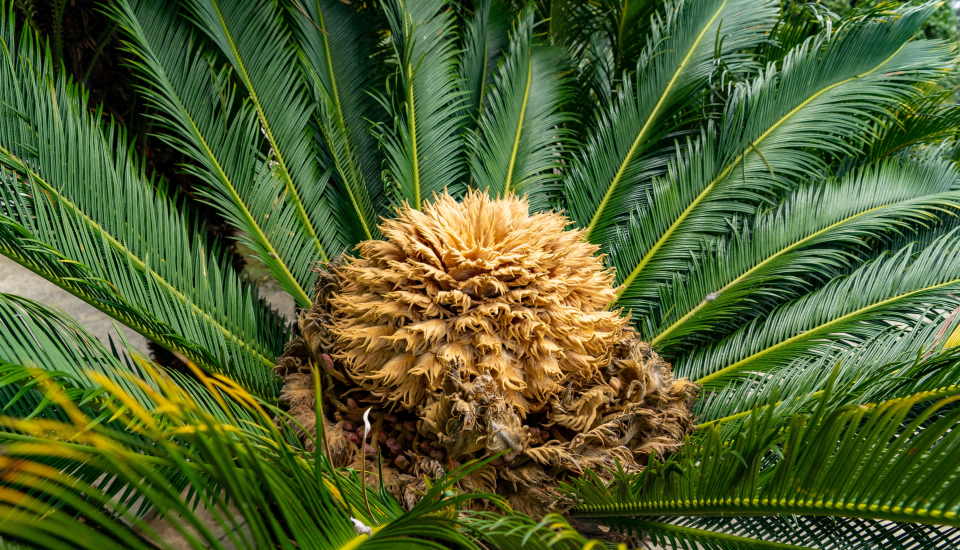
A yellow leaf on a sago palm will get its green back in 3 to 6 weeks if it is caused by mineral deficiencies. However, old brown leaves or yellow leaves that are caused by pest damage or moisture stress may not recover.
So yellow leaves that are caused by mineral deficiencies will get their green back in a matter of weeks, but if the damage is caused by overwatering, underwatering, or moisture stress, they probably will not recover.
You may also be interested in:
How to Keep Begonias Blooming?


